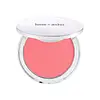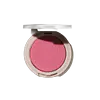What's inside
What's inside
 Key Ingredients
Key Ingredients

 Benefits
Benefits

 Concerns
Concerns

 Ingredients Side-by-side
Ingredients Side-by-side

Synthetic Fluorphlogopite
Mica
Cosmetic ColorantMagnesium Myristate
Hdi/Trimethylol Hexyllactone Crosspolymer
Polymethyl Methacrylate
Octyldodecyl Stearoyl Stearate
EmollientSqualane
EmollientHydrogenated Polycyclopentadiene
Stearoyl Glutamic Acid
CleansingSilica
AbrasiveTrifolium Pratense Flower Extract
AstringentSodium Hyaluronate
HumectantButyrospermum Parkii Butter
Skin ConditioningSimmondsia Chinensis Seed Oil
EmollientTocopheryl Acetate
AntioxidantSilica Dimethyl Silylate
EmollientIsopentyldiol
Humectant1,2-Hexanediol
Skin ConditioningButylene Glycol
HumectantCaprylyl Glycol
EmollientHexylene Glycol
EmulsifyingPhenoxyethanol
PreservativeEthylhexyl Palmitate
EmollientIron Oxides
CI 77742
Cosmetic ColorantCI 15850
Cosmetic ColorantCI 45380
Cosmetic ColorantSynthetic Fluorphlogopite, Mica, Magnesium Myristate, Hdi/Trimethylol Hexyllactone Crosspolymer, Polymethyl Methacrylate, Octyldodecyl Stearoyl Stearate, Squalane, Hydrogenated Polycyclopentadiene, Stearoyl Glutamic Acid, Silica, Trifolium Pratense Flower Extract, Sodium Hyaluronate, Butyrospermum Parkii Butter, Simmondsia Chinensis Seed Oil, Tocopheryl Acetate, Silica Dimethyl Silylate, Isopentyldiol, 1,2-Hexanediol, Butylene Glycol, Caprylyl Glycol, Hexylene Glycol, Phenoxyethanol, Ethylhexyl Palmitate, Iron Oxides, CI 77742, CI 15850, CI 45380
Synthetic Fluorphlogopite
Magnesium Myristate
Squalane
EmollientHdi/Trimethylol Hexyllactone Crosspolymer
Stearoyl Glutamic Acid
CleansingOctyldodecyl Stearoyl Stearate
EmollientHydrogenated Polycyclopentadiene
Nylon-12
Polymethyl Methacrylate
Silica
AbrasiveCaprylyl Glycol
Emollient1,2-Hexanediol
Skin ConditioningMica
Cosmetic ColorantCI 77491
Cosmetic ColorantCI 15850
Cosmetic ColorantCI 45410
Cosmetic ColorantCI 77007
Cosmetic ColorantSynthetic Fluorphlogopite, Magnesium Myristate, Squalane, Hdi/Trimethylol Hexyllactone Crosspolymer, Stearoyl Glutamic Acid, Octyldodecyl Stearoyl Stearate, Hydrogenated Polycyclopentadiene, Nylon-12, Polymethyl Methacrylate, Silica, Caprylyl Glycol, 1,2-Hexanediol, Mica, CI 77491, CI 15850, CI 45410, CI 77007
Ingredients Explained
These ingredients are found in both products.
Ingredients higher up in an ingredient list are typically present in a larger amount.
1,2-Hexanediol is a synthetic liquid and another multi-functional powerhouse.
It is a:
- Humectant, drawing moisture into the skin
- Emollient, helping to soften skin
- Solvent, dispersing and stabilizing formulas
- Preservative booster, enhancing the antimicrobial activity of other preservatives
Caprylyl Glycol is a humectant and emollient, meaning it attracts and preserves moisture.
It is a common ingredient in many products, especially those designed to hydrate skin. The primary benefits are retaining moisture, skin softening, and promoting a healthy skin barrier.
Though Caprylyl Glycol is an alcohol derived from fatty acids, it is not the kind that can dry out skin.
This ingredient is also used as a preservative to extend the life of products. It has slight antimicrobial properties.
Learn more about Caprylyl GlycolCi 15850 is the pigment color red. It is an azo dye and created synthetically.
Azo dyes need to be thoroughly purified before use. This allows them to be more stable and longer-lasting.
This ingredient is common in foundations, lipsticks, and blushes. This color is described as brown/orangey red.
It has many secondary names such as Red 6 and Red 7. According to a manufacturer, Red 6 usually contains aluminum.
Learn more about CI 15850This ingredient is a powder used to improve texture, slip, and give products a silky texture.
We don't have a description for Hydrogenated Polycyclopentadiene yet.
We don't have a description for Magnesium Myristate yet.
Mica is a naturally occurring mineral used to add shimmer and color in cosmetics. It can also help improve the texture of a product or give it an opaque, white/silver color.
Serecite is the name for very fine but ragged grains of mica.
This ingredient is often coated with metal oxides like titanium dioxide. Trace amounts of heavy metals may be found in mica, but these metals are not harmful in our personal products.
Mica has been used since prehistoric times throughout the world. Ancient Egyptian, Indian, Greek, Roman, Aztec, and Chinese civilizations have used mica.
Learn more about MicaOctyldodecyl Stearoyl Stearate is created from stearic acid.
It is an emollient and thickens the lipid (oil) portion of a product. Due to its emollient properties, it may not be fungal-acne safe.
This ingredient is also known as PMMA. It is a polymer microsphere, composed of tiny, perfectly spherical particles formed from repeating units.
In cosmetics, PMMA is mainly used to give a soft or blurring effect. The transparent particles are able to scatter light and help reduce the appearance of fine-lines and imperfections.
PMMA is also able to enhance the texture of products by add a smooth feel.
Learn more about Polymethyl MethacrylateSilica, also known as silicon dioxide, is a naturally occurring mineral. It is used as a fine, spherical, and porous powder in cosmetics.
Though it has exfoliant properties, the function of silica varies depending on the product.
The unique structure of silica enhances the spreadability and adds smoothness, making it a great texture enhancer.
It is also used as an active carrier, emulsifier, and mattifier due to its ability to absorb excess oil.
In some products, tiny microneedles called spicules are made from silica or hydrolyzed sponge. When you rub them in, they lightly polish away dead skin layers and enhance the penetration of active ingredients.
Learn more about SilicaSqualane is an emollient that helps the skin hold onto moisture. It's an oily liquid that occurs naturally in certain types of fish and plant oils.
Because squalane boosts hydration in the skin, it also comes with plenty of benefits: it is an antioxidant and can help fight free radicals and skin damage. Squalane is also found to have a detoxifying effect when applied.
Squalane comes from squalene, which occurs naturally within the sebum of our skin. It is one of the oils our skin produces to keep itself hydrated. Squalane is the hydrogenated version of squalene and has a longer shelf life.
Research shows that squalane is non-irritating (even at 100% concentration).
In general, it's a fantastic ingredient. It does a great job at hydrating the skin, and it's suitable for those with sensitive skin.
The source of squalane may impact malassezia / fungal acne. This is because olive oil derived squalane can contain impurities such as fatty acids and plant waxes. Sugarcane derived squalane is recommended for anyone with malassezia concerns.
Is squalane vegan?
This depends on the source. Squalane can be derived from both plants and animals. Most squalane used in skincare comes from plants.
Please note: the source of squalane is only known if disclosed by the brand. We recommend reaching out to the brand if you have any questions about their squalane.
Read more about squalene with an "e".
Is squalane an oil?
Squalane is often called an oil, but it’s technically not; it’s a hydrocarbon, meaning it’s only made of carbon and hydrogen, unlike true oils which are triglycerides made of fatty acids and glycerol.
The term “oil-free” isn’t regulated, so companies can define it however they want. Some exclude all oils, while others just avoid mineral oil or comedogenic oils.
While some people avoid oils thinking they cause breakouts, the right kind of oil (or oil-like ingredient like squalane) can actually help balance and hydrate your skin. It’s worth testing out simple oils or squalane to see what works best for your skin.
Learn more about SqualaneWe don't have a description for Stearoyl Glutamic Acid yet.
Synthetic Fluorphlogopite is the synthethic version of mica. It consists of fluorine, aluminum and silicate.
Synthetic Fluorphlogopite is used to add volume to products.
It is considered non-irritating on the skin.
Learn more about Synthetic Fluorphlogopite